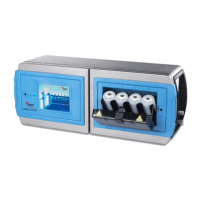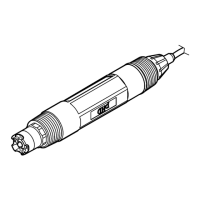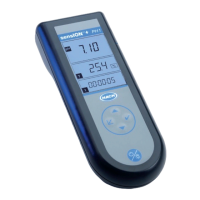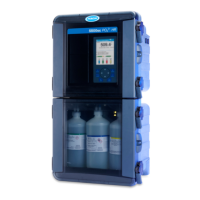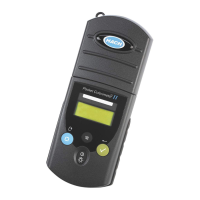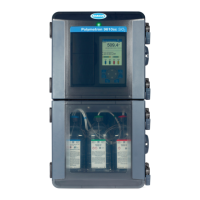Standby mode
In standby mode, the analyzer makes sure that the lamp is off and the valves are open. To exit
standby mode, select a different run mode.
Offline mode
In offline mode, the analyzer makes sure that the lamp is off, the valves are closed and flow through
the analyzer has stopped. To exit offline mode, select a different run mode.
Manual TOC sample
A TOC analysis can be done manually. Push the TOC manual sample
icon, then select the source
stream for analysis if a dual-stream analyzer. The analyzer immediately stops its current operation
and then does one TOC analysis. When the analysis is complete, the analyzer goes back to the
mode selected on the run mode screen.
Self clean mode
Select the source stream for the self-clean operation if a dual-stream analyzer. If Timed is not
selected, the self cleaning continues until it is stopped by the user.
In manual self clean mode, first the elapsed time is set to 0, the cell valve is opened to flush the cell
and the lamp is set to on. If Timed is selected, the time that remains shows. If Timed is not selected,
the elapsed time shows.
To stop the cleaning, push the red X or select a different run mode.
Bottle mode
Calibration and validation
Bottle mode is used to do calibration, validation and system suitability test procedures. Proper
calibration of the analyzer is critical to optimum instrument performance. Such functions can be done
automatically with the Onboard Automated Standards Introduction System (OASIS
™
) with the
touchscreen interface. This method minimizes user intervention with the use of a prepackaged
standards kit with RFID technology. Calibration, validation and system suitability test procedures can
be done immediately or scheduled to be done later.
• Calibration assures the accuracy of instrument readings at regular intervals. This instrument is
calibrated at the factory before shipment. It is not necessary to do a TOC calibration before the
analyzer is put into service.
• Validation ensures the accuracy of the calibration. A standard solution of known value is analyzed
to challenge the calibration.
• Calibration and validation involve the analyses of one or more standard solutions and blanks
(protocols) to identify the analyzer response.
• In bottle mode, the analog output stays at the last online TOC, conductivity and temperature
values. The TOC and conductivity alarms are deactivated.
Five functions are available under bottle mode: run standards, grab sample, excursion mode, bottle
flush and unload bottles.
Onboard Automated Standards Introduction System (OASIS)
The PAT700 Onboard Automated Standards Introduction System (OASIS) is used to do standards
tests, grab sampling and excursion sampling. Through the bottle mode, various bottle test functions
can be selected. The OASIS system is automated through the use of RFID technology. Refer to
RFID technology on page 53. When standards bottles with RFID tags are installed in the system,
the analyzer uses RFID technology to read and transmit data about the standards to the analyzer.
This system removes the need for manual data entry.
Bottles without RFID tags may also be used. The standards data is entered manually when prompted
by the analyzer.
RFID technology
The PAT700 analyzer Onboard Automated Standards Introduction System (OASIS
™
) uses Radio
Frequency Identification (RFID) technology, a registered radio frequency device. The RFID system in
English 53
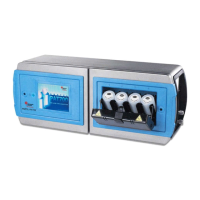
